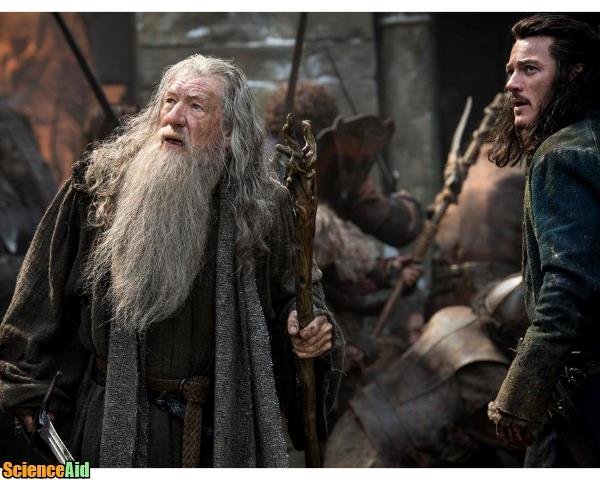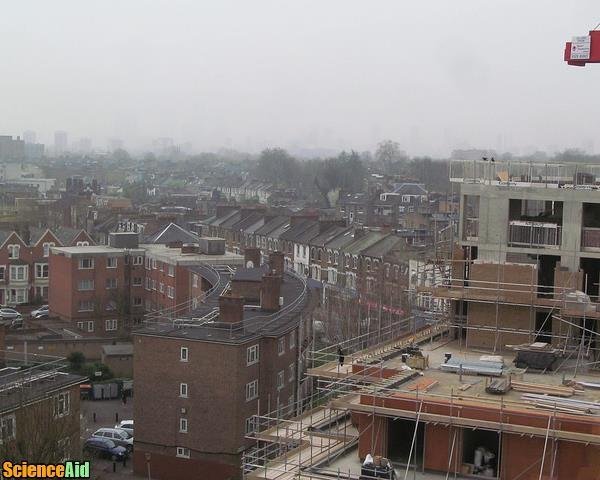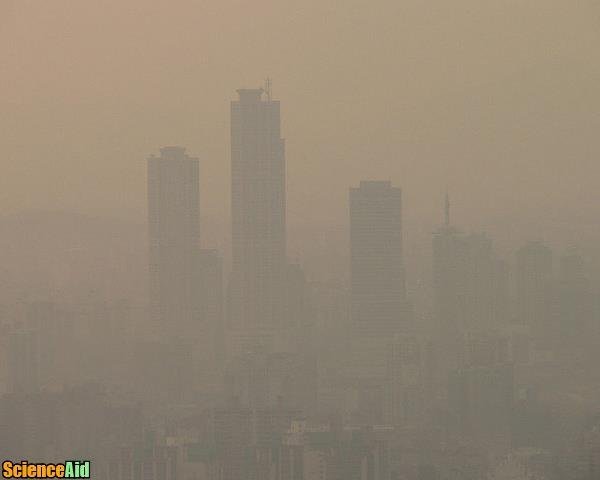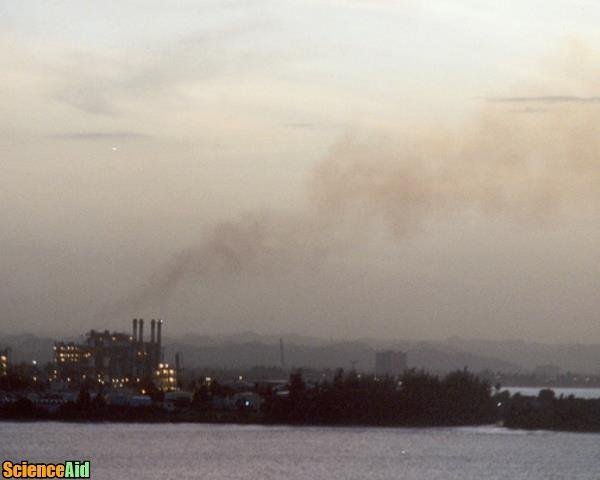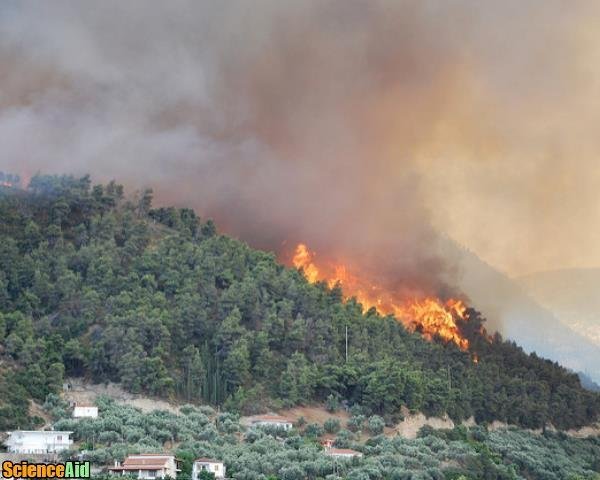Ambient Air Pollution
Edited by Marisha, Sharingknowledge, SarMal
At the beginning of the 20th century, a 24 year old member of the Lancashire Fusiliers sat in the bottom of a World War I trench while the newest innovations of war; tanks, machine guns and flame throwers were employed around him. A child born after the Industrial Revolution, the soldier had already been witness to the affects and destruction the advancement of man had on nature. But it was not until he sat with trench fever jotting down the effects of the war around him that his vision of a new world began. Discouraged by this destruction, this new world didn't include man but instead was filled with elves, dwarfs and magic and was a world with nature as its centre, propelled by forces of good battling forces of evil.
This new world became one of the most famous in literary history and has progressed into the 21st century as our prominent look into the purity and triumph of nature versus the darkness and destruction of industrialization. The world was Middle Earth, and the young soldier jotting down notes and ideas in a World War I trench? That of course was J.R.R Tolkien.
The world Tolkien created was inundated with images of the purity of nature and caution to a world already forgoing environmental preservation for technological and industrial advancement. A comparison of Tolkien's Lindon, Lothlórien, and Rivendell to the black engines and factories of Mordor is evidence of this contrast.
Ultimately, Tolkien was convinced that nature would overcome and revenge man's destruction against it, evident by Gandalf's promise "the Ents are going to wake up and find that they are strong."
At present, flamethrowers and tanks aren't the foremost forces destroying the real Earth (though environment destruction through war inevitably continues), the most prominent threat continues to be that which was identified by a much younger Tolkien as he witnessed the transformation of England through the mechanized production of the industrial revolution. Over 100 years later, the effects of industrialization are not only still present but continue to worsen, the most significant of which is air pollution.
-
1 Definition
- 1.1 Activities Leading To Air Pollution
- 1.2 Effects of Air Pollution: Humans
- 1.3 Effects of Air Pollution: Plants
- 1.4 Causes of Air Pollution
- 1.5 1. Artificial Sources
- 1.6 2. Natural Sources
- 1.7 Categories of Air Pollutants
- 1.8 1. Stationary Source
- 1.9 2. Mobile Source
- 1.10 Relative Proportion of Air Pollutants
- 1.11 Controlling Air Pollution
- 2 Referencing this Article
- 3 Comments
Definition
Air is what gives earth life, allowing us to breathe. When it is uncontaminated, air is made up of two gases, nitrogen (78%) and oxygen (21%), with a few additional inert gases (carbon dioxide and argon) present in very very small quantities (1% combined). The atmosphere of the earth is a layer of air. Air becomes polluted when adverse substances material such as atmospheric particulates, chemicals or biological molecules are supplemented to the air.
Similar to resolving the degree of pollutant in water, the quantity of a chemical in the air differentiates between undamaging and polluted. A very rudimentary example is to think of your bathtub. If you add one drop of bubble bath to your bath water, you may see the effect of the bubble bath on the water. The bubble bath has changed the water in some way, however, if you add the entire bottle of bubble bath you will absolutely easily see, smell and feel the effect of the bubble bath to the water. When thinking about air pollution the severity is caused by the concentration of the added foreign substance.
The constant range of various gases in the air is:
- N2 = 78%
- O2 = 21%
- CO2 = 0-0.03%
- Inert gases = 1%
According to the World Health Organization, the presence of substances in the atmosphere by the activities of man in a concentration sufficient to interfere with comfort, safety and health is known as air pollution. Air pollution is one of the most significant kinds of pollution witnessed today. It is reported across the world in industrial areas and metropolitan (densely populated) areas like Beijing, China; New Delhi, India and Bakersfield in California, U.S. The WHO reports "in 2014, 92% of the world population was living in places where the WHO air quality guidelines levels were not met. Ambient (outdoor air pollution) in both cities and rural areas was estimated to cause 3 million premature deaths worldwide in 2012. Some 88% of those premature deaths occurred in low- and middle-income countries, and the greatest number in the WHO Western Pacific and South-East Asia regions [1].
Activities Leading To Air Pollution
In the U.S., about 253 million cars and trucks are on the road throughout the year and burn 220 billion gallons of fossil fuel which release pollutants like nitrous oxides and carbon monoxide into the atmosphere.
The Chinese government is trying to tackle air pollution in major cities as the country gets 69% of its electricity source by burning coal. The coal used in Chinese power plants is high in sulphur (70%) which is released into the atmosphere during combustion causing air pollution. The Chinese city of Xingtai ranks 9th within the World's Most Polluted Cities' list. China began 2017 with Beijing and Tianjian engulfed in smog with issued smog warnings, highway and airport closures implemented. 70 nearby cities were also surrounded by smog at levels twice the daily concentration of 250 µg/m³ that the U.S. Environmental Protection Agency considers hazardous to human health [2].
Effects of Air Pollution: Humans
The Global Burden Of Disease Project reported in 2016 that 5.5 million people were dying prematurely each year as a result of air pollution and most of these deaths are occurring in China, India and other South-east Asian countries [3]. Air pollution is a major environmental risk to health. By reducing air pollution levels, countries can reduce the burden of disease from stroke, heart disease, lung cancer, and both chronic and acute respiratory diseases, including asthma [4].
One of the earliest examples of air pollution related mass deaths is the Great Smog of London in 1952. Nearly all of London's 8 million inhabitants used open coal fires during winter. A blanket of cold air from the European continent became stationary over the British capital and caused the warm, smoke-laden air from homes and power stations to cool and fall back to Earth. It created a blanket of sulfurous smog so dense that visibility was less than half a metre and more than 4,000 people died due to respiratory illnesses.
Because a human being inhales air about 22,000 times a day and the body takes in 16 kilograms of oxygen, polluted air containing hazardous chemicals like lead oxides, carbon monoxides, and particulate matter enter the respiratory system and cause serious illnesses.
Effects of Air Pollution: Plants
Plants and trees are extremely susceptible to the harmful effects of air pollutants as they are constantly exposed to the elements. The visible effects of air pollution on fauna are mottled leaves, blackened tips, stunted growth, premature leaf drop or early drop of blossoms and reduced yield. The annual loss of food and fiber crops, ornamental plants and trees in the United States alone due to air pollution is estimated to be one billion dollars a year.
Causes of Air Pollution
The causes of air pollution can be divided into pollution arising from artificial sources and natural sources
1. Artificial Sources
- 1Studies suggest about 2/3 of Carbon monoxide, about half of hydro carbons and nitrous oxides present in the air are released by automobiles. Combustion of fuel also releases particulate matter and lead particles which are harmful pollutants.Automobiles: Cars, buses and motorcycles all use fossil fuels and are a huge source of air pollutants.Advertisement
- 2They are responsible for 2/3rd of the Sulphur oxides present in the atmosphere around us. The plants use fossil fuels like coal and diesel to generate electricity thus releasing Sulphur oxides and other particles in the air.Power plants: Electricity generating power plants are the second biggest contributor to air pollution.
- 3These factories release lead, mercury, asbestos and Sulphur dioxides into the air which are the direct cause of diseases like asthma, lung cancer and neurological damage in children.Industries: Factories involved in activities like the refining of crude oil, manufacturing of plastic goods, mining and ore processing, lead smelting, chemical manufacturing, and dye industry are the top contributors to pollutants in the air.
- 4The combustion of fossil fuels to produce heat is a major contributor to air pollution.Heating processes: Many countries still burn wood and other fossil fuels to heat their homes as well as commercial spaces.
- 515% of global carbon dioxide emissions can be said to be due to the transport industry.Transportation industry: Trucks and trains use fossil fuels to transport goods over long distances.
- 6This is one of the main reasons inhaling second-hand smoke is said to be as harmful as actually smoking a cigarette. Recent studies also suggest that smoking releases more pollutants into the air than a diesel car.Smoking Tobacco Products: Smoking cigarettes and other tobacco products release harmful particulate matter and carcinogens into the air like nicotine and hydrogen cyanides.
2. Natural Sources
- 1These fires rage across hundreds of acres and completely devastate the local flora and fauna. The fires release huge amounts of particulate matter into the air which cause irritation and respiratory problems. Wildfires burn down large tracts of forests and the wood smoke contains hazardous gasses like carbon monoxide, carbon dioxide and ozone (O3).Burning of Forests: Wildfires in summer have become a common occurrence across the world due to rising temperatures.
- 2During spring, pollen grains and spores are carried by the wind which is exhibited as allergens.Soil Erosion: Due to soil erosion, a large amount of dust is carried from one area to another which act as air pollutants.
- 3A volcanic eruption releases gaseous compounds like Sulphur, carbon dioxide and particulate matter like ash into the air causing pollution.Volcanic Eruption:Periodic volcanic eruptions also contribute to an increase in air pollution.
Categories of Air Pollutants
John H. Seinfield in 1986, categorized air pollutants into the following types:
1. Stationary Source
Stationary sources of air pollution are large, fixed sources that emit a high amount of pollutants but can be controlled.
- Point source emits air pollutants from one or more controllable sites. For example, smoke stacks of factories and power plants.
- Fugitive sources emit air pollutants from open areas exposed to the wind and other non-controllable factors. For example farming practices that involve scorch earth or construction sites are referred to as fugitive air pollutant sources.
- Area source of air pollutants can be defined as 'a well-defined location that is a major and constant source of air pollutant and which houses several sources such a city which has construction sites, power plants and factories.
2. Mobile Source
Mobile sources of air pollutants are those that are not stationary in nature and emit pollutants while moving from one location to another. Two major mobile sources of air pollutants are automobiles and aircraft.
Relative Proportion of Air Pollutants
| Source of Pollutant | % of Total Air Pollutant |
|---|---|
| Transportation | 59.9% |
| Industries | 18.8% |
| Generation of electricity | 12.5% |
| Space heating | 6.3% |
| Garbage disposal | 2.6% |
| Chemicals | % of Total Air Pollutants |
|---|---|
| Carbon Dioxide | 52% |
| Oxides of Sulphur | 18% |
| Particulate Matter | 10% |
| Oxides of Nitrogen | 6% |
| Gases & Vapours | 2% |
| Hydrocarbons | 12% |
Controlling Air Pollution
The atmosphere has several built-in self-cleaning processes such as dispersion, rain washout, gravitational settling, absorption and so forth to cleanse the atmosphere. However, efforts need to be made to control or reduce a number of air pollutants being released into the atmosphere.
1. Source Control
Since we know the substances that act as pollutants, the first approach will be through source reduction.
- Ensure that automobiles and transport vehicles use only unleaded petrol.
- Use petroleum products that have low Sulphur and cash content.
- Reduce automobiles on the road by developing an efficient public transport network while encouraging people to use them or walk or use bicycles.
2. A-forestation
Planting of new forests and planting trees in urban areas will ensure natural filters in the environment as trees utilize carbon dioxide and release oxygen thus returning balance to the environment.
3. Town Planning
Narrow streets lined with tall, glass buildings cause a build-up of pollutants and increase the ground temperature. Therefore during town planning, wider streets and shorter buildings should be encouraged. Industries and waste disposal sites should be located outside the city centre.
4. Catalytic converters
Use catalytic converters to help control the emission of carbon monoxide and hydrocarbons.
5. Control Devices
To reduce the dispersion of pollutants in the air, atmosphere control devices can also be used.
- Gravity settling chamber
- Fabric filters
- Cyclonic scrubbers
- Bag filters
- Electrostatic precipitators
By using the above methods, a considerable amount of particulate matter and pollutants can be prevented from being released into the atmosphere and acting as harmful pollutants.
Referencing this Article
If you need to reference this article in your work, you can copy-paste the following depending on your required format:
APA (American Psychological Association)
Ambient Air Pollution. (2017). In ScienceAid. Retrieved Apr 26, 2024, from https://scienceaid.net/Air_Pollution
MLA (Modern Language Association) "Ambient Air Pollution." ScienceAid, scienceaid.net/Air_Pollution Accessed 26 Apr 2024.
Chicago / Turabian ScienceAid.net. "Ambient Air Pollution." Accessed Apr 26, 2024. https://scienceaid.net/Air_Pollution.
If you have problems with any of the steps in this article, please ask a question for more help, or post in the comments section below.
Comments
Article Info
Categories : Environmental Studies
Recent edits by: Sharingknowledge, Marisha






